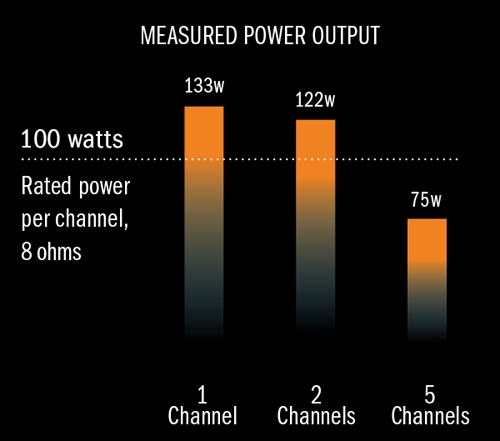Onkyo TX-SR706 A/V receiver Page 3

TEST BENCH
DOLBY DIGITAL PERFORMANCEAll data were obtained from various test DVDs using 16-bit dithered test signals, which set limits on measured distortion and noise performance. Reference input level is -20 dBFS, and reference output is 1 watt into 8 ohms. Volume setting for reference level was -8. All level trims at zero, except for subwoofer-related tests, all speakers were set to "large," subwoofer on. All are worst-case figures where applicable.
Output at clipping (1 kHz into 8/4 ohms) 1 channel driven: 133/202 W (21.2/23.1 dBW) 5 channels driven (8 ohms): 75 W* (18.8 dBW) Distortion at 1 watt (THD+N, 1 kHz) 8/4 ohms: 0.03/0.04% Noise level (A-wtd): -75.4 dB Excess noise (with sine tone) 16-bit (EN16): 0.5 dB Frequency response: 20 Hz to 20 kHz +0, -0.1 dB
*Approximate result; with 5 or more channels driven the receiver protected, effectively shutting down, after approximately a half-second of drive at full output
MULTICHANNEL PERFORMANCE, ANALOG INPUTReference input and output level is 200 mV; volume setting for reference output level was -4. Distortion (THD+N, 1 kHz, 8 ohms): 0.004% Noise level (A-wtd.): -92.6 Frequency response: <10 Hz to 200 kHz +0, -3 dB
STEREO PERFORMANCE, DIGITAL INPUTReference level is -20 dBFS; all level trims at zero. Volume setting for reference level was -4. Output at clipping (1 kHz, 8/4 ohms, both channels driven): 122/178 W (20.9/22.5 dBW) Distortion at reference level: 0.02% Linearity error (at -90 dBFS): 0.05 dB Noise level (A-wtd): -75.6 dB with 96-kHz/24-bit signals: -85.0 dB Excess noise (with/without sine tone) 16-bit (EN16): 0.9/0.5 dB quasi-20-bit (EN20): 10.3/9.8 dB Noise modulation: 0.7 dB Frequency response: <10 Hz to 20 kHz +0, -0.15 dB with 96-kHz/24-bit signals: <10 Hz to 47 kHz +0, -0.8 dB
BASS-MANAGEMENT PERFORMANCEMeasured results obtained with Dolby Digital test signals. Subwoofer-output frequency response (crossover set to 80 Hz): 24 dB/octave (approx.) above -6-dB rolloff point of 81 Hz High-pass-filter frequency response (crossover set to 80 Hz): 12 dB/octave below -3-dB rolloff point of 80 Hz Maximum unclipped subwoofer output (trim at 0): 9.2v Subwoofer distortion (from 6-channel, 30-Hz, 0-dBFS signal; subwoofer trim set to 0): 0.03% Crossover consistency: bass crossover frequency and slope were consistent for all sources and formats Signal-format consistency: consistent for all applicable formats Speaker size selection: all channels can be set to "small" Speaker-distance compensation: available for all main channels.
The TX-SR706's lab results were almost without exception excellent, with near-reference noise, linearity, response, and distortion. The sole exception was power output: While the unit cheerfully produced around 80 watts with five channels driven into 8 ohms, like some other mid-priced receivers it would only do so for short periods (a few hundred milliseconds) before current-limiting to approximately one-fourth power. But this situation is very unlikely ever to occur in actual use with real program material, which is far less demanding than sine tones and which virtually never peaks more than one or two channels simultaneously. My listening tests (performed as always before lab measurements) never elicited any shortage of power or dynamic freedom. Note that the above results all reflect the Onkyo's "6 ohms" software setup option. When set to the 4 ohms position, which presumably current-limits the power amps, results declined uniformly to about 35 watts maximum.








































